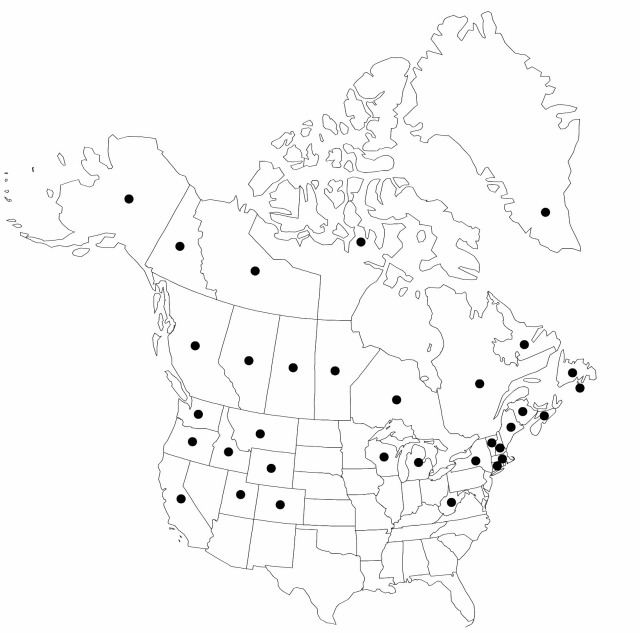Carex deflexa
Fors. Oecon. Plantel. ed. 3, 1: 938. 1821.
Plants usually loosely cespitose; rhizomes spreading to erect, purplish brown to reddish-brown, 0–10 mm, slender. Culms arching to spreading, 5–31 cm, smooth or scabrous distally; bases (remnants of old leaves) weakly or not at all fibrous. Leaf-blades pale green, shorter to longer than culms, 0.9–2.6 (–3.2) mm wide, herbaceous, glabrous abaxially, scabrous adaxially. Inflorescences with both staminate and pistillate spikes; peduncles of basal spikes slender, elongate, erect; peduncles of distal spikes 0.6–4 (–10) mm; proximal nonbasal bracts leaflike, equaling or exceeding inflorescences. Spikes: pistillate spikes 1–4 (basal spikes 0–2); cauline spikes overlapping, separated by less than 7 mm, with 4–15 perigynia; distal staminate spikes 3.1–11.3 × 0.7–2.7 mm. Scales: pistillate scales pale to dark reddish-brown, with narrow to broad white margins, ovate, 2–2.8 × 1–1.8 mm, shorter than perigynia, apex obutse, acute, or acuminate (cuspidate on some basal spikes); staminate scales ovate, 2.4–4 × 1–1.9 mm, apex acute to acuminate. Anthers 1.2–2.5 mm. Perigynia yellowish green to grayish green, veinless, globose to obovoid, 2.3–3.1 × 1–1.4 mm, as long as or longer than wide; beak often bent, pale green, occasionally with reddish-brown tinge, 0.4–0.8 mm, ciliate-serrulate, apical teeth 0.1–0.2 mm. Stigmas 3. Achenes brown, obovoid, obtusely trigonous in cross-section, 1.3–1.6 × 1–1.4 mm.
Distribution

Alta., B.C., Man., N.B., N.S., N.W.T., Ont., Que., Sask., Yukon, Alaska, Calif., Colo., Conn., Idaho, Maine, Mass., Mich., Mont., N.H., N.Y., Oreg., Utah, Vt., W.Va., Wash., Wis., Wyo.
Discussion
Varieties 2 (2 in the flora).
Selected References
None.
Lower Taxa
Key
| 1 | Staminate spikes 3.1–5.7 × 0.7–1.1 mm. | Carex deflexa var. deflexa |
| 1 | Staminate spikes 6.3–11.3 × 1–2.7 mm. | Carex deflexa var. boottii |
"shortened" is not a number.